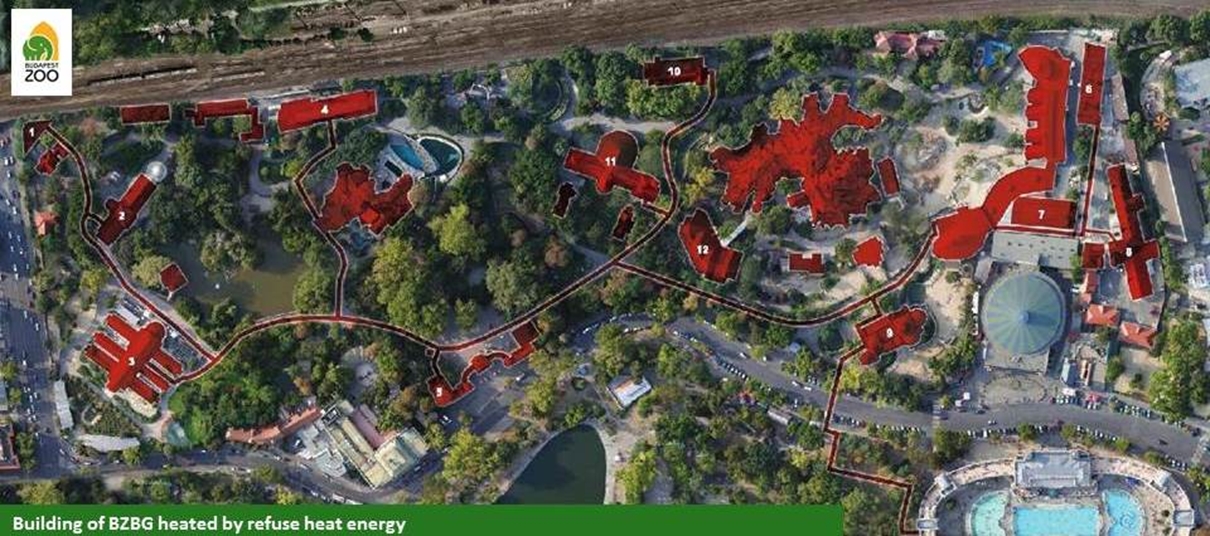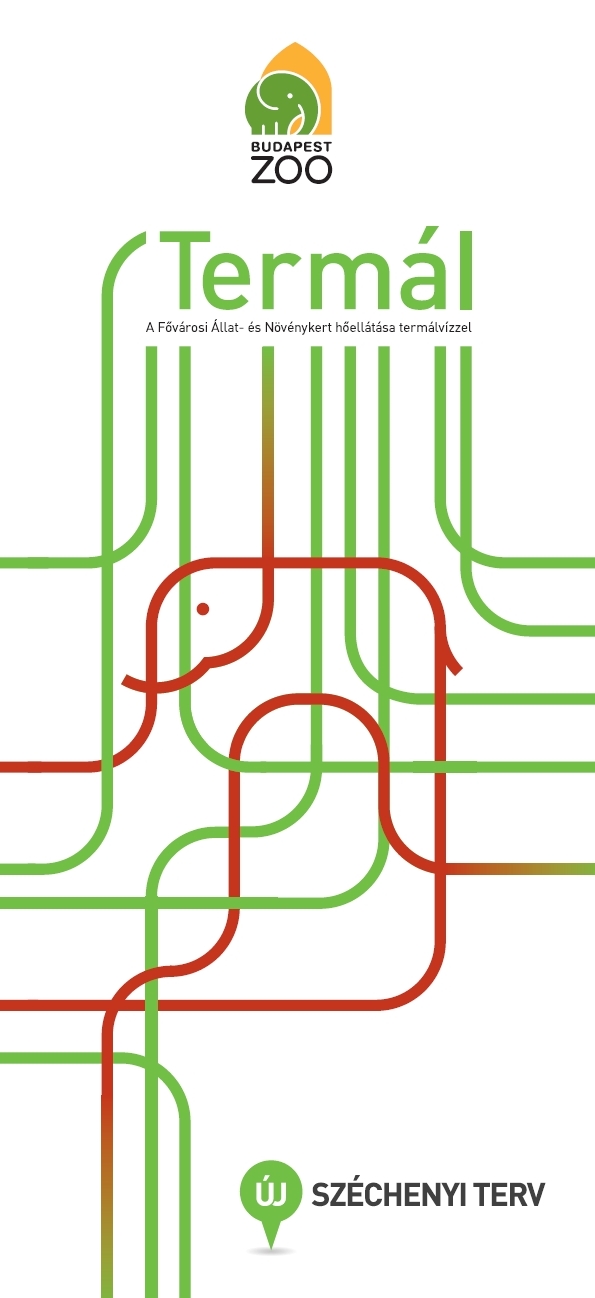- HUNMagyar
Thermal Project at Budapest Zoo
Background and objectives:
In 2011, Budapest Zoo & Botanical Garden, Széchenyi Thermal Bath and Budapest District Heating Company joined forces to reduce the carbon emission of the Zoo and spare on energy costs by realizing the heat and hot water supply of the Zoo with the collaboration of the Spa.
The level of the annual gas consumption of the Budapest Zoo was significant prior to the installation of the new system, mainly because several buildings (e.g. the buildings accommodating the tropical plants and animals) need heat supply throughout the majority of the year. Furthermore, many species require higher average temperatures than usual. Fortunately, the Zoo is located close to the Spa which allows supplying the territory of the Zoo with waste heating energy by thermal water origin.
Implementation:
The water coming out of the Széchenyi well is at a very high temperature (around 75 oC). Therefore it must be cooled down before the guests can enjoy it. The key idea to establish the new heating system in the Zoo was to consider this temperature difference as a surplus energy that the Zoo could utilize in its heating system. Thus, rather than carrying out a costly cooling operation, it was decided to use this surplus energy to heat the facilities at the Zoo.
The Spa itself also uses some of this energy surplus to heat its own facilities, therefore the water temperature arriving to the Zoo is varying depending on the actual weather situation (outdoor temperature, wind, etc.).
Technical measures:
A heat exchanger unit was installed in the Bath, from where a pair of insulated heating pipes start, integrating the buildings of the Zoo into the system via a heating centre located in the basement of the Old Elephant House. The thermal water itself does not leave the territory of the Spa; after the heat exchange, warm water conveys the heat into 26 buildings of the Zoo through the pair of pipes going underground. There are 14 heating centres (2 main + 12 substations) , monitored and regulated by a computer system.

In each building, a required interior air temperature is determined. When the energy demand changes due to the open-air temperature, the institution uses thermal water space heating to adjust to the basic, continuous heating. When it comes to an extreme cold weather and the temperature of the refuse heat is not able to maintain the required interior temperature, gas boilers of the earlier system support the additional necessary heating.
Financing:
The thermal heating system of the Budapest Zoo was realized under the Central Hungary Development Programme of the Hungarian government with the support of the European Regional Development Fund (ERDF). The Fund granted 60% of the total budget, the remaining part was provided by the City Council of Budapest (30%), as a remunerative credit for the Zoo, and the Zoo itself (10%) from its own resources.
The total budget of the project amounted to HUF 314 918 061 (cca. EUR 1,05 million), out of which HUF 188 950 837 (cca. EUR 630 000) was granted by the European Union. The co-financing provided by the Budapest Zoo was HUF 125 967 224 (ca 420 000 EUR) partly ensured by the Budapest City Council as a zero-rate loan.
The estimated return of the project is 12 years, technical lifetime is 40 years, means it has supported not only EU 2020, but EU 2050 targets as well.
---
In 2010, the Zoo consumed more than 1000 tonnes of CO2 (800 thousand cubic meter gas), costing nearly 100 million HUF (360 thousand EUR). The costs of waste thermal heating system operation are about the third of gas heating. The Zoo now only uses gas heating to support the thermal heating system when needed, thus, according to calculations it emits over 600 tonnes less of CO2/year. This leads to a saving of approximately 150.000 EUR of gas costs annually.
The Zoo undertook the following indicators after the implementation:
Usage of renewable energy sources: 8000 GJ/year
Reducing greenhouse gas emissions: 539 tonnes/year
By far, the Zoo successfully complies with these indicators.
It should also be noted that the energy supply of the Zoo is now based on two pillars, making it less vulnerable to unexpected events than the previous system.
Széchenyi Thermal Bath also saves money owing to this geothermal project. As mentioned above, the water coming out of its artificial well is at a very high temperature therefore it must be cooled down before people can bathe in it. Now, rather than carrying out a costly cooling operation, the temperature difference is partly used to heat facilities at the Zoo. Furthermore, the Spa even makes some profit from delivering this energy to the Zoo.
In 2009, Budapest Zoo & Botanical Garden and the Budapest Spas and Hot Springs Ltd. reached an agreement about the utilization of the waste heat of Széchenyi Thermal Bath; later on the local district heating company also joined in the project. The Budapest Spas and Hot Springs Ltd. undertook to provide freely the thermal energy from its run-off waters and to sell other thermal energy at a significant discount to the Zoo. After the metropolitan district heating company become a partner, a technical conception was prepared about a new heating system for the Zoo.
The Zoo has been dealing with the modernization of its energy supply and the reduction of the cost of energy used for several years. In this spirit of modernization, traditional gas boilers have been gradually replaced by modern condensation gas boilers and the control of heating systems were also modernized.
In September 2011, the Széchenyi Thermal Bath, Budapest Zoo and the local district heating company laid down the foundation tube of the new heating system supplying the whole territory of the Zoo with geothermal energy.
This pioneering venture has been beneficial for all three parties:
The Zoo could cover a large part of its heat demand from a cheaper and safer energy source. The Spa could save a significant amount that would have been spent on the cooling system of the thermal water coming from the well and can make profit from delivering heat energy to the Zoo.
The District Heating Company has gained a new partner and strengthened its sustainable energy supply profile.
Our project is a nice example and a really good practice for utilization of waste heating energy in a typical win-win construction using district heating technology.
First and last, this project resulted much better economic and ecological situation in Budapest Zoo & Botanical Garden ultimately good for all living beings: directly for animals and plants in the Zoo and around as well as for 1 million zoo visitors/year and for the staff, indirectly for inhabitants of Budapest and the agglomeration.
